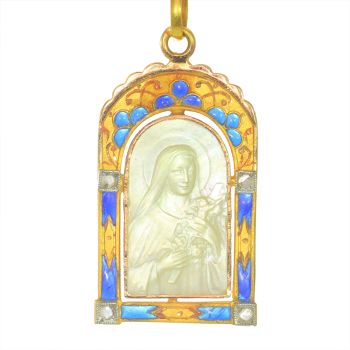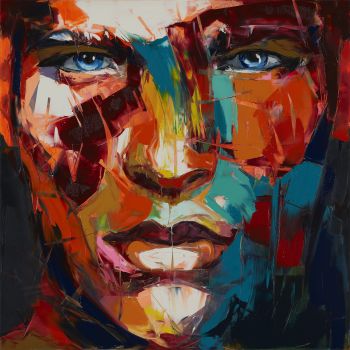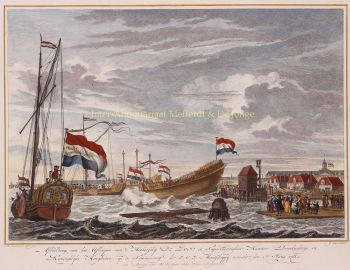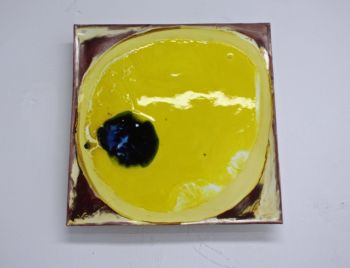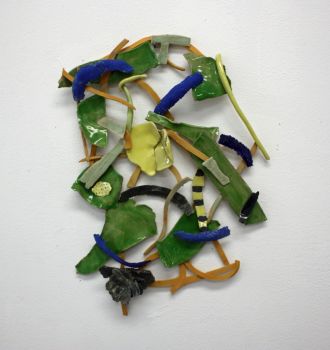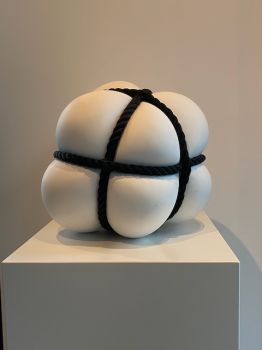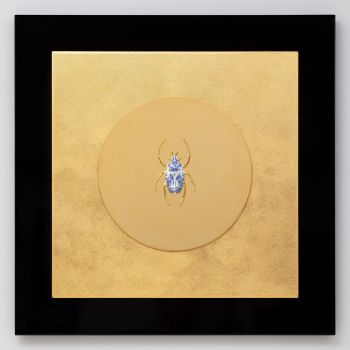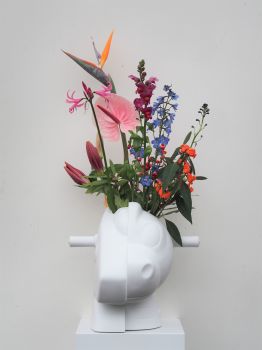Chinese plate after Esaias van de Velde, 18th century Qianlong 1735 - 1796
Artista Desconocido
Porcelana
38 ⨯ 38 cm
ConditionVery good
€ 1.850
Verkoulen Oriental & European Antiques
- Sobre la obra de arteChinese porcelain plate after Esaias van de Velde
A large octangle shaped Chinese Qianlong period (1735-1796) plate with a Western subject after a design from Esaias van de Velde.
18th century, around 1750, Jingdezhen, China. Blue and white
Dimensions: 38,5 x 38 cm.
This rare plate depicts a Dutch landscape with in the middle a river and fishers on a sampan. The seated figure is surrounded by a larger tree, Western buildings, a gatehouse and a typical fence. The plate is a beautiful example of ‘chine de commande’ in the Qianlong period (1735-1796). We know that a Delft tile is used as an example for the design of the plate. This (or a similar tile) was probably brought to China by the Dutch merchants of the Dutch East Indian Company as a sample for new patterns on plates. Meanwhile in China, the Chinese artisans gave their own interpretation to the sample given. Similar plates with the same kind of setup but with pagodas and a Chinese landscape are very common. The Western ‘chine de commande’ subjects were on the other hand usually made on special order because it was more expensive.
The Dutch Delft tile is nowadays located in Castle Twickel in Delden. The design of the tile is directly made after an engraving (etching) of Esaias van de Velde (1587-1630). The engraving where we can see again the landscape with a river and gatehouse has the inscription ‘Hofstede’ and is made between 1613-1617. Beside its unusual shape, the subject with the information of the origin makes it a special item for collectors.
Condition: Good, one minor restoration to the start of a tiny hairline that can only be seen on the back. - Sobre el artista
Puede suceder que un artista o creador sea desconocido.
Algunas obras no deben determinarse por quién está hecho o por (un grupo de) artesanos. Algunos ejemplos son estatuas de la Antigüedad, muebles, espejos o firmas que no son claras o legibles, pero también algunas obras no están firmadas en absoluto.
También puedes encontrar la siguiente descripción:
•"Atribuido a …." En su opinión, probablemente una obra del artista, al menos en parte.
•“Estudio de….” o “Taller de” En su opinión, una obra ejecutada en el estudio o taller del artista, posiblemente bajo su supervisión
•“Círculo de…” En su opinión, una obra del período del artista que muestra su influencia, estrechamente asociado con el artista pero no necesariamente su alumno.
•"Estilo de …." o “Seguidor de…”. En su opinión, una obra ejecutada al estilo del artista pero no necesariamente por un alumno; puede ser contemporáneo o casi contemporáneo
•"Manera de …." En su opinión una obra al estilo del artista pero de fecha posterior
•"Después …." En su opinión, una copia (de cualquier fecha) de una obra del artista
•“Firmado…”, “Fechado…” o “Inscrito” En su opinión, la obra ha sido firmada/fechada/inscrita por el artista. La adición de un signo de interrogación indica un elemento de duda.
•“Con firma…”, “Con fecha…”, “Con inscripción…” o “Lleva firma/fecha/inscripción” en su opinión la firma/fecha/inscripción ha sido añadida por alguien que no es el artista
¿Está interesado en comprar esta obra de arte?
Artwork details
Related artworks
- 1 - 4 / 12
Artista Desconocido
Series of 6 Chinese cups and saucers (Yongzheng period)1722 - 1735
Precio a consultarKuipers Kunst & Antiek
1 - 4 / 11Artista Desconocido
PAREJA DE ANTORCHAS O VELAS DE TECA DORADA Y LACADA INDONESIA18th century
Precio a consultarZebregs & Röell - Fine Art - Antiques
Artista Desconocido
UNA COLECCIÓN DE CUATRO CAJAS BÍBLICAS DE MARFIL DE SRI LANKAN18th century
Precio a consultarZebregs & Röell - Fine Art - Antiques
Artista Desconocido
UN RARO TELESCOPIO DE CUERO LACADO JAPONÉS GRANDE1750 - 1800
Precio a consultarZebregs & Röell - Fine Art - Antiques
Artista Desconocido
The Stamford Raffles Secretaires.1800 - 1813
Precio a consultarZebregs & Röell - Fine Art - Antiques
Artista Desconocido
UN MODELO JAPONÉS DE UN NORIMONO, UN PALANQUÍN1650 - 1700
Precio a consultarZebregs & Röell - Fine Art - Antiques
Artista Desconocido
UN NETSUKE MARINE MARFIL DE UN HOLANDÉS CON UN VENTILADOR CHINO18th century
Precio a consultarZebregs & Röell - Fine Art - Antiques
Artista Desconocido
UN NETSUKE DE MARFIL DE UN HOLANDÉS CON UNA COCKEREL18th century
Precio a consultarZebregs & Röell - Fine Art - Antiques
1 - 4 / 24Artista Desconocido
PAREJA DE ANTORCHAS O VELAS DE TECA DORADA Y LACADA INDONESIA18th century
Precio a consultarZebregs & Röell - Fine Art - Antiques
Gyrinus
Vidrio grabado punteado con putti1764 - 1766
Precio a consultarPeter Korf de Gidts - Antiquairs
Artista Desconocido
A silver spoon commemorating Juff’ Margareta van Hoorn1656 - 1694
Precio a consultarZebregs & Röell - Fine Art - Antiques
Artista Desconocido
UN NETSUKE DE MARFIL DE UN HOLANDÉS CON UNA COCKEREL18th century
Precio a consultarZebregs & Röell - Fine Art - Antiques
Artista Desconocido
A large Japanese Imari porcelain 'VOC Groningen' dish1800 - 1925
Precio a consultarZebregs & Röell - Fine Art - Antiques
Artista Desconocido
The bell of the VOC fortress in Jaffna, Sri Lanka1747
Precio a consultarZebregs & Röell - Fine Art - Antiques
 curada por
curada porDanny Bree
1 - 4 / 24Artista Desconocido
A large Japanese Imari porcelain 'VOC Groningen' dish1800 - 1925
Precio a consultarZebregs & Röell - Fine Art - Antiques
Samuel Dejong
Anatomia Blue Heritage, Hercules Open2017 - 2019
Precio a consultarVilla del Arte Galleries
 curada por
curada porGallerease Magazine
Samuel Dejong
Anatomia Blue Heritage, Atlas Closed2017 - 2019
Precio a consultarVilla del Arte Galleries
Artista Desconocido
Series of 6 Chinese cups and saucers (Yongzheng period)1722 - 1735
Precio a consultarKuipers Kunst & Antiek
Samuel Dejong
Anatomia Blue heritage II Goliath Beetle closed BGG2019
Precio a consultarVilla del Arte Galleries
1 - 4 / 24- 1 - 4 / 5






